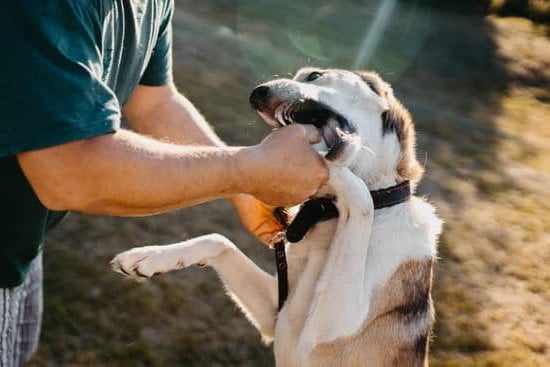Are you wondering how to train a dog 6 months old? Training a puppy at this stage is crucial for their development and well-being. Understanding the developmental stage of a 6-month-old dog is essential in providing effective training and ensuring they grow into well-behaved adult dogs. From basic obedience training to socialization and dealing with common behavior issues, there are various aspects to consider when training a dog at this age.
At 6 months old, a dog is entering their adolescent stage, marked by increased independence and curiosity. This phase can be challenging for both the dog and the owner, but it’s also an important time for setting boundaries and teaching proper behavior. Basic obedience training becomes crucial during this stage, as it helps establish rules and routines that will shape the dog’s behavior as they mature.
Socialization is another key aspect of a 6-month-old dog’s development. Properly introducing your puppy to new people, animals, and environments can prevent future behavioral problems and ensure they grow up to be confident and well-adjusted dogs. In addition to basic obedience training and socialization, house training, potty training, crate training, leash training, positive reinforcement techniques, dealing with common behavior issues, and advanced training tips are all vital components of effectively training a 6-month-old dog.
Basic Obedience Training for a 6-Month-Old Dog
Training a 6-month-old dog in basic obedience is an essential part of their development and will set the foundation for future training. At this stage, your dog is still young and impressionable, making it a great time to instill good habits and behaviors. Here are some basic obedience training tips for a 6-month-old dog:
- Start with simple commands: Begin with teaching your dog basic commands such as sit, stay, come, and down. Use positive reinforcement techniques such as treats and praise to reward good behavior.
- Consistency is key: Be consistent with your training methods and expectations. Use the same cues and hand signals each time you give a command to avoid confusion.
- Practice short training sessions: Your 6-month-old dog may have a shorter attention span, so keep training sessions brief and frequent. Aim for multiple short sessions throughout the day rather than one long session.
It’s important to keep in mind that every dog is different, so be patient and flexible with your training approach. Additionally, consider enrolling your 6-month-old dog in a puppy obedience class where they can socialize with other dogs and receive guidance from a professional trainer.
Remember that positive reinforcement is key to successful obedience training at this age. By using treats, praise, and play as rewards for good behavior, you can encourage your 6-month-old dog to learn and follow commands effectively. With patience and consistency, you can effectively train your 6-month-old dog in basic obedience skills.
Socialization Tips for a 6-Month-Old Dog
At 6 months old, your dog is in the midst of a crucial developmental stage. Socialization is an important aspect of their training at this age, as it helps them become well-adjusted and well-behaved adult dogs. Here are some tips on how to effectively socialize your 6-month-old dog:
1. Introduce them to different environments: Expose your dog to various situations and environments, such as the park, pet-friendly stores, or busy streets. This will help them feel comfortable and confident in different settings.
2. Meet new people and pets: Encourage positive interactions with other people and animals to teach your dog appropriate social behavior. It’s essential for them to learn how to properly interact and communicate with others.
3. Positive reinforcement: Use treats, praise, and rewards to reinforce good behavior when socializing your 6-month-old dog with new people and pets. This will help them associate positive experiences with social interactions.
Remember that every dog is different, so take things at their own pace and never force interactions if they seem uncomfortable. By following these socialization tips, you can help your 6-month-old dog grow into a well-mannered adult companion.
Crate Training for a 6-Month-Old Dog
Crate training is an essential aspect of raising a well-behaved and disciplined 6-month-old dog. It provides them with a safe and secure space to relax and also helps in preventing destructive behavior when you are not around. When done correctly, crate training can also aid in housebreaking your dog, as the crate becomes their den where they learn to control their bladder and bowels.
To start crate training your 6-month-old dog, it’s important to choose the right crate size. The crate should be big enough for them to stand up, turn around, and lie down comfortably, but not too large that they can create a separate potty area inside. Once you have the appropriate crate, introduce your dog to it gradually. Place some toys or treats inside to encourage them to explore the crate willingly.
When starting out with crate training, it’s important to associate positive experiences with the crate. Use positive reinforcement techniques such as offering treats or verbal praise when your dog enters the crate on their own. To further establish a positive association with the crate, feed your dog their meals inside it. This helps them view the crate as a place of comfort and security rather than punishment.
One crucial aspect of successful crate training is never using the crate as a form of punishment. The goal is for your 6-month-old dog to see their crate as a safe haven, so avoid turning it into a negative experience for them. With patience and consistency, most dogs learn to love their crates and see them as their own personal space within just a few days or weeks.
| Aspect | Description |
|---|---|
| Crate Size | The proper size for the dog’s comfort. |
| Positive Reinforcement | Using treats or verbal praise when implementing positive behaviors. |
| Punishment | Avoiding use of the ciate for punishment. |
House Training and Potty Training for a 6-Month-Old Dog
Understanding the Importance of House Training
House training or potty training is an essential part of teaching your 6-month-old dog proper behavior in the home. It not only helps to maintain cleanliness but also establishes good habits that will last a lifetime. Understanding the developmental stage of a 6-month-old dog is crucial as they are at an age where they can start to control their bladder and bowel movements, making it an ideal time to focus on house training.
Consistency and Patience
To effectively house train a 6-month-old dog, consistency and patience are key. Establishing a routine for feeding, potty breaks, and playtime can help your dog understand when and where they should go to the bathroom. You should take them outside frequently, especially after meals or naps, and reward them with praise or treats when they eliminate in the appropriate area. Avoid punishing accidents indoors as this can create anxiety and hinder the training process.
Crate Training as an Aid
Crate training can be beneficial for house training your 6-month-old dog. Dogs have a natural instinct to keep their sleeping area clean, so by confining them in a crate when unsupervised, you can prevent indoor accidents. However, it’s important to gradually introduce the crate and ensure that it is not used as punishment.
The crate should be just big enough for your dog to stand up, turn around, and lie down comfortably. This creates a den-like environment where they are less likely to eliminate. Gradually increasing the time spent in the crate can also aid in building bladder control.
By understanding the importance of house training, practicing consistency and patience, and utilizing crate training as an aid, you can effectively teach your 6-month-old dog proper potty behavior in the home. Remember that every dog is unique, so it’s essential to tailor your approach to fit their individual needs while following fundamental principles of positive reinforcement.
Leash Training and Walking Etiquette for a 6-Month-Old Dog
When training a dog that is 6 months old, it is essential to remember that they are still in the developmental stage. At this age, they are full of energy and curiosity, which can make leash training and walking etiquette challenging. It’s important to understand that patience and consistency are key when training a dog of this age.
Basic obedience training is crucial before starting leash training. Commands such as “sit,” “stay,” and “come” will be helpful when teaching your 6-month-old dog how to walk on a leash. These commands will also help establish trust and communication between you and your furry friend.
One effective way to start the leash training process is by getting your dog used to wearing a collar or harness. Let them wear it around the house for short periods to get comfortable with it. Once they are comfortable with wearing the collar or harness, you can begin introducing the leash. Using positive reinforcement techniques, such as rewards and treats, will help make the experience positive for your dog as they learn how to walk on a leash.
| Training Method | Description |
|---|---|
| Basic Obedience Training | Commands such as sit, stay, and come are essential before starting leash training. |
| Patient & Consistent | Patience and consistency are key when training a 6-month-old dog. |
| Positive Reinforcement | Rewards and treats can be used as positive reinforcement when teaching leash training. |
Positive Reinforcement Techniques for Training a 6-Month-Old Dog
Positive reinforcement is an effective method for training a 6-month-old dog, as it focuses on rewarding good behavior rather than punishing bad behavior. This approach helps the dog to associate certain actions with positive outcomes, making them more likely to repeat those behaviors in the future. Here are some positive reinforcement techniques that can be used to train a 6-month-old dog:
Clicker Training
Clicker training is a popular positive reinforcement technique for dogs of all ages, including 6-month-olds. It involves using a clicker – a small hand-held device that makes a clicking sound – to mark the moment the dog performs the desired behavior.
The click is then followed by a reward, such as a treat or praise. Over time, the dog learns to associate the click with the reward and will begin to perform the desired behavior in order to hear that click.
Treat-Based Training
Using treats as a reward is another effective way to train a 6-month-old dog using positive reinforcement. Small, high-value treats can be used to motivate the dog and reinforce good behavior during training sessions. It’s important to use treats that your dog finds particularly enticing, as this will increase their motivation to learn and follow commands.
Verbal Praise and Affection
In addition to treats, verbal praise and affection are also important tools for positive reinforcement training. Dogs thrive on attention from their owners, so telling them “good boy” or giving them scratches behind the ear can be just as rewarding as receiving a treat. This type of positive feedback helps build trust and strengthens the bond between you and your 6-month-old dog.
By implementing these positive reinforcement techniques, you can effectively teach your 6-month-old dog essential commands and behaviors while strengthening your bond with them at the same time. Remember that consistency and patience are key when it comes to training a young pup, so be sure to practice these techniques regularly and always provide plenty of love and encouragement throughout each training session.
Dealing With Common Behavior Issues in a 6-Month-Old Dog
At six months old, a dog is still considered a young puppy and may exhibit some common behavior issues as they continue to develop. It’s important for pet owners to understand that these behavior issues are normal at this stage of their dog’s life and can be addressed with patience, consistency, and positive reinforcement. One of the key ways to address common behavior issues in a 6-month-old dog is through basic obedience training.
One common behavior issue that can arise in a 6-month-old dog is excessive chewing or destructive behavior. This is often a result of teething and the need for mental stimulation. To address this issue, provide plenty of appropriate chew toys and redirect your dog’s attention when you catch them chewing on something they shouldn’t be. Additionally, engage in regular play and exercise sessions to help tire out your energetic puppy.
Another common behavior issue is jumping up on people or furniture. While this may seem cute when they are smaller, it can become problematic as they grow older and larger. To discourage jumping, ignore your dog when they jump up and only give them attention or affection when all four paws are on the ground. Consistency is key in addressing this behavior issue, so make sure all members of the household are on board with the training approach.
Leash pulling is another issue that may arise at this age, especially as your dog becomes more confident during walks. Leash training and walking etiquette are important skills to teach at this stage. Use positive reinforcement techniques such as treats or praise to reward your dog for walking nicely on the leash without pulling. Gradually increase the duration of walks as your dog learns to walk politely by your side.
Advanced Training Tips for a 6-Month-Old Dog
In conclusion, training a dog at 6 months old is an important stage in their development that can set the foundation for good behavior and obedience. Understanding the developmental stage of a 6-month-old dog is crucial when it comes to training. At this age, they are more capable of learning and retaining information, making it an ideal time to reinforce training and socialization.
Basic obedience training serves as a solid starting point for a 6-month-old dog, focusing on sit, stay, come, and other essential commands. Socialization tips are also vital at this stage, as it helps them become well-adjusted and well-behaved around people and other animals. Additionally, crate training not only aids in housebreaking but also provides the dog with a safe and secure space.
House training and potty training are essential for maintaining cleanliness in the home while leash training and walking etiquette ensure that walks are enjoyable for both the dog and owner. Positive reinforcement techniques are highly effective in instilling good behavior in a 6-month-old dog.
Lastly, advanced training tips can help take your dog’s skills to the next level, including agility exercises or specialized tricks. By following these training guidelines, you can help your 6-month-old dog become a well-behaved and obedient companion for years to come.
Frequently Asked Questions
Can You Still Train a 6 Month Old Puppy?
Yes, you can definitely still train a 6-month-old puppy. In fact, this is a crucial age for training and socialization. You can start with basic commands like sit, stay, and come, as well as proper leash walking.
Is 6 Months Too Late to Train a Dog?
It’s not too late to train a dog at 6 months old. While it may be easier to start training at a younger age, 6 months is still considered a good time to teach your dog obedience and proper behavior. Consistency and patience are the keys to successful training at this age.
How Do You Discipline a 6 Month Old Dog?
When disciplining a 6-month-old dog, it’s important to use positive reinforcement over punishment. Reward good behavior with treats or praise, and redirect negative behavior by showing them the correct way to behave. Consistency in training and setting clear boundaries are crucial for effectively disciplining your dog during this stage of their development.

Welcome to the blog! I am a professional dog trainer and have been working with dogs for many years. In this blog, I will be discussing various topics related to dog training, including tips, tricks, and advice. I hope you find this information helpful and informative. Thanks for reading!





